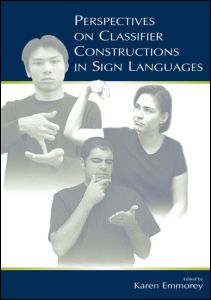Classifiers in spoken and in signed languages: how to know more
Aikhenvald, Alexandra Y. (2003) Classifiers in spoken and in signed languages: how to know more. In: Emmorey, Karen, (ed.) Perspectives on classifier construction in sign languages. Lawrence Erlbaum, Mahwah, NJ, USA, pp. 87-90.
![[img]](https://researchonline.jcu.edu.au/9067/2.hassmallThumbnailVersion/9067_Aikhenvald_2003_cover.jpg)
|
Image (JPEG) (cover)
Download (11kB) |
|
|
PDF (Published Version)
Restricted to Repository staff only |
Abstract
Almost all languages have some grammatical means for the linguistic categorization of noun referents. 'Classifiers' is an umbrella label for the continuum of noun categorization devices, from lexical numeral classifiers of South-East Asia to highly grammaticalized gender agreement classes of Indo-European languages. They provide a unique insight into how the world is categorized through language in terms of universal semantic parameters involving humanness, animacy, gender, shape, form, consistency, orientation in space and functional properties of entities.
Classifiers are overt morphemes that constitute a grammatical system and serve to arrange nominal referents into semantically defined classes. A language has classifiers if it possesses Classifier Constructions. These are understood as separate grammatical units-such as noun phrases, verb phrases, or clauses-which require classifiers, chosen according to the semantics of a noun.
Classifiers in spoken languages come in different guises. Noun classes or genders (as in Spanish) are highly grammaticalized agreement classes based on such core characteristics of noun referents as animacy, sex, humanness and sometimes also shape. In some languages, most nouns are assigned to just one noun class; in other languages different noun classes can be chosen to highlight a particular property of a referent.
| Item ID: | 9067 |
|---|---|
| Item Type: | Book Chapter (Research - B1) |
| ISBN: | 978-0-8058-4269-2 |
| Additional Information: | This publication does not have an abstract. The first three paragraphs of this chapter are displayed as the abstract. |
| Date Deposited: | 22 Jul 2010 00:12 |
| FoR Codes: | 20 LANGUAGE, COMMUNICATION AND CULTURE > 2004 Linguistics > 200407 Lexicography @ 100% |
| SEO Codes: | 95 CULTURAL UNDERSTANDING > 9502 Communication > 950201 Communication Across Languages and Culture @ 100% |
| Downloads: |
Total: 111 Last 12 Months: 5 |
| More Statistics |



